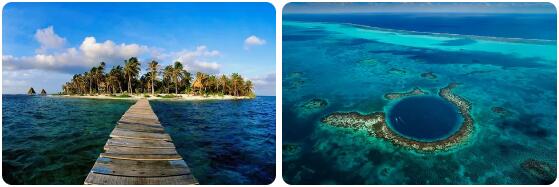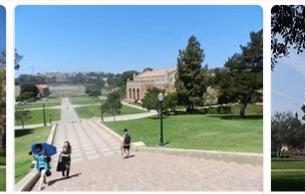“Sub umbra floreo” – I blossom in the shade
[motto of the country]
With a size of 22,965 km², which hardly exceeds that of the German state of Hesse, Belize, located between Mexico and Guatemala, is the second smallest state on the entire American continent after El Salvador.
Belize has been part of the Commonwealth of Nations since 1981 and – like no other country in Central America – English is the official language.
On the coast of the former English colony “British Honduras” in the Caribbean Sea, the Barrier Reef and its cayes (= small coral islands) are the second largest coral reef in the world after the Great Barrier Reef off Australia. It stretches along the entire coast of Belize and offers countless small reefs, sandbanks and islands protection.The cayes and the coast of the country are mostly covered by wide, dense mangrove forests.
Belize also has three of the only four Caribbean atolls, including the famous Blue Hole, an indescribable paradise for fans of diving.
Despite its small area, small Belize impresses with a great variety of landscapes, some of which is completely untouched. While flat areas extend in the north of the country and the coastal region is littered with the aforementioned magrove trees, dry savannahs extend inland and the Mountain Pine Ridge and the Maya Mountains south-west of Belize City.
The south of Belize belongs to the jungle, which makes up 40% of the total land area and represents the largest closed remainder of the tropical rainforest.
The flora and fauna of the country can hardly be described. Thousands of plant species shape it, while tapirs, monkeys, river crocodiles, and pumas live in the forests and rivers. With the Cockscomb Basin Wildlife Sanctuary, Belize also has the only jaguar reserve on earth. So the visitor to the country will see incredible things.
In Belize, which is more Caribbean than Spanish, many ethnic groups live together, which differ both culturally and linguistically. In addition to the mestizos and Creoles, there are the Mayas, Garifuna and Mennonites in the country. Even if Belize City is the largest city in terms of population, the Central American state has been the significantly smaller Belmopan since 1970. The planned city was built on the foothills of the Maya Mountains and forms the geographical center of the country.
In contrast to many other South and Central American states, Belize, largely spared from armed conflicts, welcomes around 200,000 visitors from all over the world every year, most of them from the United States. In addition to the cruise tourists, divers and people who are interested in the breathtaking diversity of Belize’s landscapes and the Mayan ruins in Cuello (Orange Walk District) come to the country. The latter date from the year 2000 BCE, when today’s Belize was still inhabited by the Maya alone.
| Name of the country | Belize |
| Form of government | Parliamentary democracy |
| Geographical location | Central America in the southeast of the Jukatan peninsula |
| National anthem | Land of the Free |
| Population | approx. 408,500 (Credit: Countryaah: Belize Population) |
| Ethnicities | Around 50% of the people are mestizos, 21% Creoles, 11% indigenous people (mostly Maya),5% Garifuna (Black Caribbean Indians) and 9% European, Indian and Chinese. |
| Religions | There is no state religion. Around 50% of the population are Catholics, 27% belong to various Protestant religions.Furthermore there are about 1% Muslims and about 13% of the population is distributed among other religious communities.
approx. 9% have no religious affiliation. |
| Languages | English (official language), Spanish, Garifuna, Creole, German |
| Capital | Belmopan |
| Surface | 22,965 km² with approx. 90% forested area |
| Highest mountain | Doyle’s Delight (1,124 m) |
| Longest river | Belize River (290 km) |
| International license plate | BZ (formerly BH) |
| National currency | Belize dollars |
| Time difference to CET | -7 h |
| International phone code | 00501 |
| Mains voltage, frequency | 110 and 220 volts 60 hertz |
| Internet TLD (Top Level Domain) | .bz |
Little history of Belize
Belize is the now independent former British Honduras. It belongs to the British Commonwealth, with the Queen or the King of Great Britain as head of state. In contrast to that of other South American countries, history has meant it relatively well with Belize, because the young state did not have to go through lengthy phases of wars and civil wars. Only in 2005 there was unrest in the country because of the ailing state budget and its planned compensation through increased taxes.
Early history
According to Abbreviationfinder website, as the important archaeological discoveries in Cuello (Orange Walk District) have shown, the land that is now called Belize was already settled by the Maya around 2000 BC, whose heyday would end in the year 900. Descendants of those Maya still live in the country today.
Spanish Colonial Era
In the 16th century, the Spanish conquistadores finally came to the country, but from the outset they encountered resistance from the natives, some of whom fled inland and repeatedly fought against the Spanish Colones. Those instead remained in the areas of what is now Honduras and Mexico. Because the mountain regions and coasts of Belize as well as the conflicts with the indigenous people made activities in the interior more difficult. For this purpose, British pirates “settled” on the coasts of Belize, who used the favorable location for prey trips on Spanish ships. After this piracy had come to a standstill in 1670, the British settlers (Baymen) began trading in tropical timber, something that Spain did in 1763has been approved. From the 18th century onwards, forest work was done by African slaves, who at the end of the 18th century made up about 75% of the total population of the country (excluding the Mayans).
British colonial times
Even though many concessions had been made to the British settlers, Central America was still de facto under Spanish influence at the end of the 18th century. That changed with September 10, 1798 and the Battle of St. Georges Caye, when the British military defeated the Spaniards. The area now under English rule was to be called “British Honduras” from 1862. The Baymen, however, continued to live autonomously and invoked their constitution, the “Barnaby’s Code” of 1765. In 1833, slavery was abolished in the British Empire.
At the beginning of the 20th century the resistance of the non-European population in particular to British colonial rule had risen alarmingly, but this development led to the establishment of political parties after the Second World War and a severe economic decline until 1962. Administratively, the country was already independent when it was supposed to be renamed “Belize” in 1973.
Independence from Belize
Belize achieved complete independence from Great Britain on September 21, 1981. However, British troops continued to be stationed in the country, as neighboring Guatemala was just waiting to enforce its territorial claims in western Belize by military means. It was not until 1992 that Belize should be recognized by its neighbor as a sovereign country. However, Guatemala did not renounce to uphold the old territorial claims. Both countries are still in negotiations with one another.
Manuel Esquivel became the first Prime Minister of Belize. He was elected in 1984.

